Transforming a compact outdoor area into a stunning oasis can feel like a daunting task, yet the innovative 2025 small garden ideas showcased in the video above demonstrate that size is no barrier to beauty. Indeed, even the most modest spaces possess immense potential for creativity and charm. This deep dive expands upon those exciting concepts, offering further inspiration and practical strategies to help you craft your very own breathtaking garden paradise.
Whether you are working with a small front yard, a narrow side passage, or a cozy patio, the upcoming trends emphasize clever design and thoughtful integration. These modern approaches prove that even tiny spots can feel both alive and truly luxurious, making a significant impact on your home’s aesthetic and your personal well-being.
Embrace Vertical Gardening: Maximizing Every Inch with Smart Design
The movement toward vertical gardening is undeniably one of the most compelling 2025 garden trends, offering an ingenious solution for maximizing limited square footage. Rather than spreading horizontally, gardeners are encouraged to think upwards, creating dynamic displays that draw the eye and add considerable depth. This method transforms plain walls and fences into vibrant green canvases, providing both beauty and function.
Consider installing green walls, which can be custom-built or purchased as modular systems, perfect for housing an array of plants from colorful annuals to edible herbs. Stacked planters allow for multiple plantings in a single footprint, ideal for creating a mini herb garden or a tiered floral display. Trellises, an age-old garden staple, are experiencing a resurgence; imagine them covered in fragrant jasmine, vigorous climbing roses, or even compact berry vines. These vertical elements not only save precious ground space but also introduce dramatic height and lush layers, making even the tiniest area feel expansive and meticulously curated.
Designing with Green Walls and Trellises
When implementing green walls, select plants that thrive in shallow soil and require similar light and watering conditions. Succulents, ferns, and various trailing plants are excellent choices. For trellises, consider the mature size and weight of your chosen climbers, ensuring your support structure is robust enough. Passionflowers, clematis, and petite fruit vines can add both visual interest and a delightful sensory experience to your small landscape design.
Front Yard Transformation: Crafting a Lasting First Impression
Your front yard serves as the initial introduction to your home, and making it magical does not require extensive acreage. The key to an impressive front yard landscaping lies in thoughtful planning and attention to detail. In 2025, design philosophies for front yards lean towards either a classic, symmetrical elegance or a modern, minimalistic appeal, each creating a distinct and inviting entry.
For a classic aesthetic, consider symmetrical planting arrangements where identical elements are mirrored on either side of a pathway or entrance. Low, manicured hedges like boxwood or Japanese holly define boundaries and add structure, while flagstone or gravel pathways create a welcoming approach. Integrating traditional flowering plants such as roses, hydrangeas, or lavender can evoke a timeless charm. Conversely, a modern front yard embraces the philosophy that less is often more. This approach might feature native grasses that sway gracefully in the breeze, alongside minimalist lighting fixtures that provide subtle illumination. Sculptural planters, crafted from concrete or corten steel, house single, dramatic specimen plants like agaves or ornamental grasses, creating focal points with understated elegance.
Balancing Classic and Contemporary Elements
Achieving a cohesive look involves selecting materials and plants that complement your home’s architectural style. For a traditional home, brick pathways and wrought iron accents could enhance the classic garden. For modern residences, clean lines, geometric planters, and drought-tolerant succulents would be more fitting. Thoughtful choices ensure your front yard design truly reflects your personal style.
Creating Cozy Corners: Your Private Garden Escape
Even the smallest garden can be transformed into a personal retreat, offering a sanctuary from the everyday hustle. The trend for 2025 emphasizes crafting intimate spaces where comfort and ambiance are paramount. These cozy corners become extensions of your living space, inviting relaxation and quiet contemplation.
Furnishing these compact zones intelligently is crucial. A small bistro table and chairs can provide a perfect spot for morning coffee or an evening drink. A hanging chair or an egg chair offers a comfortable, stylish perch for reading. Built-in benches, especially those with integrated storage, maximize utility in tight spaces while providing ample seating. To enhance privacy and seclusion, surround your chosen spot with tall potted plants such as bamboo, ornamental grasses, or strategically placed screens. Bamboo screens or attractive lattice panels covered with climbing plants can effectively block unwanted views. Final touches like solar-powered fairy lights strung overhead, casting a soft, enchanting glow, and a small water feature providing soothing sounds, significantly elevate the ambiance. These elements combine to create an immersive, tranquil environment.
Choosing the Right Elements for Intimacy
When selecting plants for privacy, consider their growth habits and mature size. Clumping bamboos are excellent choices, offering dense foliage without invasive spread. For water features, opt for self-contained units like tabletop fountains or wall-mounted bubblers that require minimal space and upkeep. Soft cushions and weather-resistant textiles on furniture enhance comfort and invite lingerers.
Mixing Textures & Heights for Dynamic Visual Interest
Layering your garden like an experienced landscape designer is a fundamental principle for making small spaces feel larger, deeper, and more intentionally designed. This technique involves combining diverse plant forms and hardscape materials to create rich visual and tactile experiences. By carefully contrasting elements, you can prevent a small garden from feeling flat or monotonous, instead making it feel curated and full of dynamic energy.
Start by pairing tall, airy ornamental grasses, such as ‘Karl Foerster’ feather reed grass, with low-growing ground covers like creeping thyme or sedum. Introduce spiky architectural plants like yuccas or agaves alongside rounded, soft-textured shrubs like dwarf conifers or boxwood. This interplay of forms immediately adds visual intrigue. Beyond plants, integrate various hardscaping materials: imagine combining the smooth, cool texture of gravel paths with the warmth and natural grain of wooden decking or stepping stones. River rocks, decomposed granite, or even small patches of artificial turf can all contribute to a varied textural palette. This strategic blending of textures and heights creates an illusion of depth, inviting the eye to explore different levels and elements within the garden. It is truly a top landscaping tip for anyone looking to make a big impact in a small landscape design.
Effective Plant and Material Pairings
Consider the color and light requirements of plants when layering. For example, placing shade-loving hostas beneath taller ferns creates a lush, cool understory. When designing with hardscaping, ensure transitions between materials are smooth and logical, guiding movement through the garden. A small pathway of stepping stones leading to a cozy decking area can define distinct zones within your small garden ideas.
Sustainable Meets Style: Eco-Conscious Garden Design in 2025
The year 2025 heralds an exciting era where sustainable practices seamlessly integrate with sophisticated garden aesthetics. This approach proves that being environmentally responsible does not mean compromising on style; in fact, eco-conscious choices often enhance the unique charm and resilience of a small garden. Embracing sustainability offers both practical benefits and a deeper connection to nature.
A primary focus is on choosing drought-tolerant plants that require minimal watering once established. Lavender, rosemary, salvias, and various succulents are excellent examples that thrive in drier conditions and offer beautiful blooms or foliage. Incorporating recycled materials into your design adds character and reduces waste; think of repurposing old bricks for pathways, using reclaimed wood for raised beds, or turning discarded tires into unique planters. Solar-powered garden lights are not only energy-efficient but also offer versatile lighting solutions, from subtle path markers to enchanting string lights. Furthermore, rainwater collection systems can be designed to double as attractive garden features. Stylish rain barrels or elegant rain chains diverting water into decorative basins can become focal points, showcasing your commitment to conservation while enhancing your garden’s visual appeal. These elements demonstrate that going green has never looked so good, making your small garden ideas both beautiful and responsible.
Integrating Eco-Friendly Solutions
To maximize sustainability, consider native plants that are adapted to your local climate and soil conditions, reducing the need for extensive care and attracting local wildlife. Composting kitchen scraps and garden waste provides nutrient-rich soil amendments, further minimizing your environmental footprint. Embrace smart irrigation systems that deliver water directly to plant roots, reducing evaporation and waste. These small, thoughtful steps cumulatively contribute to a healthier planet and a more resilient, beautiful garden.











